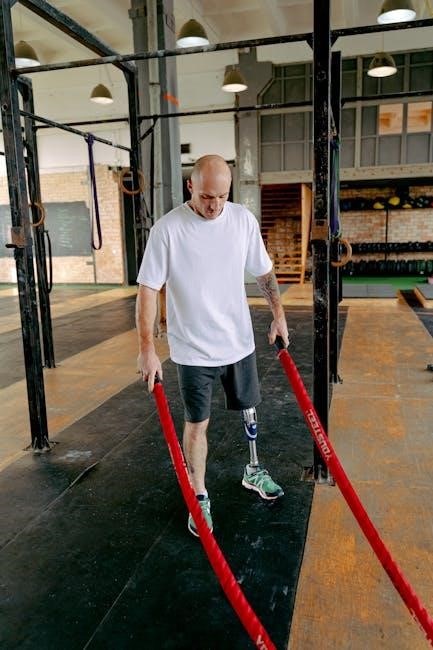approach to create a personalized rehabilitation plan, with the goal of returning to sport safely and effectively within timeframe.
Understanding Adductor Strain Injury
Adductor strain injury is a common cause of medial leg and groin pain, especially among athletes, and it occurs when the adductor muscles are stretched or torn. The adductor complex includes the three adductor muscles, which are the longus, magnus, and brevis, and the adductor longus is the most commonly injured. This type of injury can be acute or chronic, and it can be caused by a variety of factors, including overuse, poor training techniques, and inadequate warm-up or cool-down routines. The symptoms of adductor strain injury can include pain, swelling, and limited mobility, and it can be diagnosed through a physical examination and imaging tests. Understanding the causes and symptoms of adductor strain injury is essential for developing an effective rehabilitation plan. A thorough understanding of the injury can help to identify the best course of treatment and can help to prevent further injury. The adductor muscles play a crucial role in movement and stability, and any injury to these muscles can have a significant impact on an athlete’s performance. By understanding the anatomy and function of the adductor muscles, athletes and trainers can take steps to prevent injury and promote healing. Additionally, understanding the different types of adductor strain injuries can help to determine the best treatment approach.

Importance of Rehabilitation
Rehabilitation is crucial for recovery, promoting healing, and preventing future injuries, using a
structured
approach to restore function and mobility within timeframe.
Role of Ice in Injury Recovery
The application of ice is a common practice in the initial stages of injury recovery, particularly for adductor strains. Ice serves to reduce bleeding and inflammation in the affected tissue, thereby promoting the healing process. It is essential to use ice correctly, as direct contact with the skin can cause damage. A layer of cloth or towel should be placed between the ice and the skin to avoid any adverse effects. The duration and frequency of ice application may vary depending on the severity of the injury and individual tolerance. Typically, ice is applied for 15-20 minutes, several times a day, in the initial 48-72 hours following the injury. This approach helps to minimize pain and inflammation, creating a conducive environment for the rehabilitation process to commence. By incorporating ice therapy into the rehabilitation protocol, individuals can expect a more efficient and effective recovery from adductor strains. The use of ice is a simple yet effective technique that can be easily incorporated into a rehabilitation program. Regular application of ice can help reduce the risk of further injury and promote a speedy recovery.

Non-Operative Treatment Considerations

Non-operative treatment considerations involve assessing injury severity, patient health, and rehabilitation goals to create a personalized plan using a
structured approach
for optimal recovery within timeframe effectively.
Factors Influencing Rehabilitation Outcomes
Several factors influence rehabilitation outcomes, including the severity of the injury, patient’s overall health, and adherence to the rehabilitation program. The presence of associated injuries, such as hip or lower abdominal strains, can also impact the recovery process. Additionally, the patient’s age, pre-injury health status, and tissue quality can affect the rate of progress and overall outcome. A thorough assessment of these factors is essential to create a personalized rehabilitation plan. The rehabilitation program should be tailored to address the individual’s specific needs and goals, taking into account their sport, position, and level of competition. By considering these factors, healthcare professionals can develop an effective rehabilitation plan that promotes optimal recovery and minimizes the risk of re-injury. Furthermore, regular monitoring and adjustments to the rehabilitation program can help ensure that the patient is progressing at a safe and effective rate. This personalized approach can help individuals achieve a successful return to their sport or activity. Overall, the rehabilitation outcome is influenced by a complex interplay of factors, and a comprehensive approach is necessary to achieve optimal results.

Rehabilitation Protocol Overview
Rehabilitation protocol involves a structured program with specific exercises and activities to promote healing and recovery, using a
step-by-step
approach to ensure a safe return to sport within timeframe.
Criterion-Based Progression Program
A criterion-based progression program is a rehabilitation approach that focuses on the individual’s progress and achievement of specific criteria, rather than a fixed timeline. This program is designed to ensure that the individual is ready to progress to the next stage of rehabilitation, and ultimately return to their sport or activity. The program typically involves a series of exercises and activities that are tailored to the individual’s specific needs and goals. The criteria for progression are based on the individual’s ability to perform specific tasks, such as strengthening exercises, agility drills, and functional activities. The program is typically divided into several phases, each with its own set of criteria and objectives. The individual’s progress is regularly assessed and evaluated, and adjustments are made to the program as needed. This approach ensures that the individual is able to progress at their own pace, and reduces the risk of re-injury or complications. By using a criterion-based progression program, individuals can ensure a safe and effective return to their sport or activity, and achieve their rehabilitation goals. The program is often used in conjunction with other rehabilitation techniques, such as physical therapy and exercise programs.
